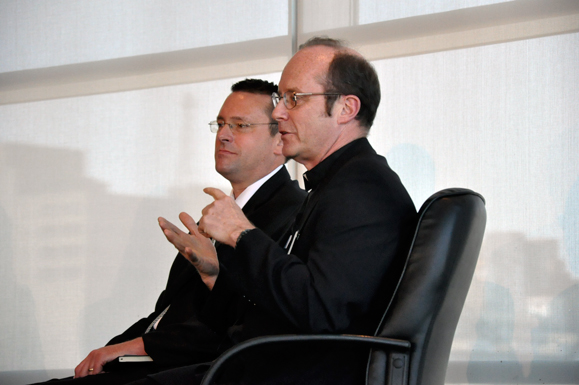
At the diocesan observance of World Communication Day, a local pastor and a publisher had some interesting things to say about how the new social media impacts parish life.
For instance, the parish bulletin, a staple in every parish on Sunday, now can be found online. Joe Luedtke, president of the E-giving division of Liturgical Publications, says his firm handles about 500 parish bulletins across the country. A recent phenomenon, he says, is the amount of on-line hits for parish bulletins from parishioners who relocate for the winter months.
“They still want to keep up with the photos of parish activities as well as the baptisms and funerals,” explains Luedtke.
Msgr. Sean Ogle, pastor of Our Lady of Mount Carmel parish, Astoria, points out that his parish bulletin is on-line before it is on paper. His parish also has several Facebook pages and a YouTube channel for the parish to serve the five different language groups in his parish.
Msgr. Ogle says that his parish also uses its website for on-line giving. Some parishioners have told him they do all their financial transactions on-line.
After eight months of offering that option, 37 donors have opted to use electronic giving. And defying the myth that only the young use computers, he points out that 75% of those who have chosen to do so are over the age of 50.
Electronic registration to the parish is another option that web users can access.
“You presume the younger generation is using the computer,” said Msgr. Ogle. “Even if they are not participating (in the parish), we’re saying to them, ‘we’re playing in your ballpark’.”
Leudtke agreed, saying that “the bottom line is the next generation is growing up on-line. It’s a completely different generation.” He explained that his teenage son hasn’t had a lesson in penmanship in years and probably will never need to use a pen or pencil to transmit his thoughts.
Both panelists agreed that websites also offer a chance for parishioners to speak back and to engage in dialogue. But each offered caveats.
Msgr. Ogle admitted that he does not tweet because “context is a big part of we communicate.” He didn’t think that nuances could be transmitted in the limited number of characters allowed by Twitter.
He also warned that immediacy isn’t always the best way to respond. “Know whom you are talking to and be careful what you say before you tweet or blog,” he said. “You should also avoid negativity but at the same time you must make the critical comments that need to be made.”
Luedtke felt it was important that respondents always identify themselves so that the conversations can remain civil and honest. “Otherwise it’s too easy to make comments without ramifications,” he said.
“The bottom line is that we have a long way to go before we’re using all this properly,” said Luedtke.
